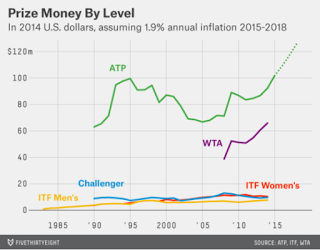

| Online: | |
| Visits: | |
| Stories: |

| Story Views | |
| Now: | |
| Last Hour: | |
| Last 24 Hours: | |
| Total: | |
Income inequality in tennis: a startling problem
Read aguanomics http://www.aguanomics.com/ for the world’s best analysis of the politics and economics of water  Corneill writes*
Corneill writes*
Novak Djokovic. Andy Murray. Roger Federer. These three household names exemplify the glamour, fame and glory that comes with reaching the elite rankings of professional tennis, played by millions of people worldwide. However, in stark contrast to this, the majority of professional tennis players rarely even cover their costs of a year on the tour, regularly making substantial losses and being totally dependant on sponsors or their parents.
Income inequality refers to how evenly or unevenly income is distributed among a population. It is most commonly measured by the Gini coefficient, which, according to the World Bank, measures “the extent to which the distribution of income or consumption expenditure among individuals or households within an economy deviates from a perfectly equal distribution”. A Gini coefficient of zero indicates that there is perfect equality, whereas a value of zero suggest that there is total inequality (one person has all the income).
In tennis terms, there is increased participation competing for prize money, which on paper, is said to be growing. The body which runs the biggest and most lucrative tournaments, the ATP World Tour, announced that prize money would be increased over the coming four years. However, these would be biggest for the “500” and “1000” level tournaments which are normally exclusive to the top 50 ranked players (with increases of 50% and 54% respectively in 2018 compared to this year). The problem is that this is not uniform throughout the board — the lowest tier of tennis, the ATP Challenger Tour, has not been given an increase in prize money, which would insinuate that with the current rate of inflation (especially with the rising costs of travel) the players who compete more regularly in the Challenger Tour are actually worse off. This means that only the very top players stand to earn substantial money, and the gap between them and the rest keeps on growing. The governing body of tennis, the International Tennis Federation (ITF) revealed [pdf] that only 336 men and 253 women made a net profit whilst playing tennis in 2014. Relating this back to economic theory, it can be said that the distribution of income is beginning to have a larger deviation from perfectly equal distribution, with a gini coefficient closer to 1 than previously.
The ITF needs to find a way to counter this, in order to prevent talented players from leaving the tour prematurely due to unbearable costs. Other sports, such as Baseball and Basketball have apparently found solutions to this: the minimum salary in the MLB is USD 500,000; and the 350th player in the NBA still earns upwards of a million dollars — more than enough to keep oneself comfortable.
Potential solutions for the tennis scene could include looking to reward emerging and upcoming players, and simultaneously start to make it harder for others who aren’t (for example, veterans playing below their level of competition).
Bottom Line Professional tennis needs to find a way to decrease income inequality throughout the tour, as an unreasonable number of players are not able to sustain the costs of competing on the tour and the governing body does have the power and money to do so.
* Please comment on these posts from my microeconomics students, to help them with unclear analysis, other perspectives, data sources, etc.
Source: http://www.aguanomics.com/2016/02/income-inequality-in-tennis-startling.html



